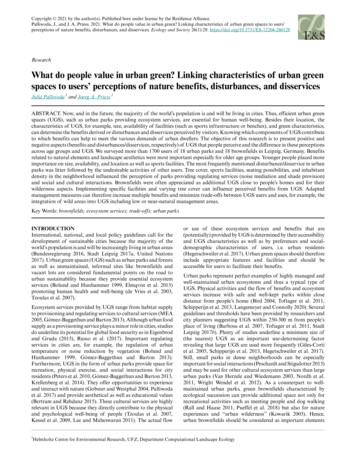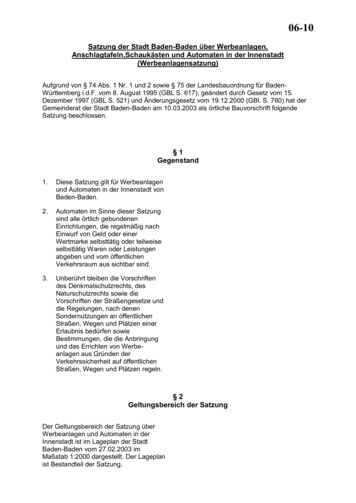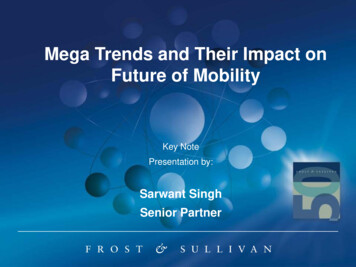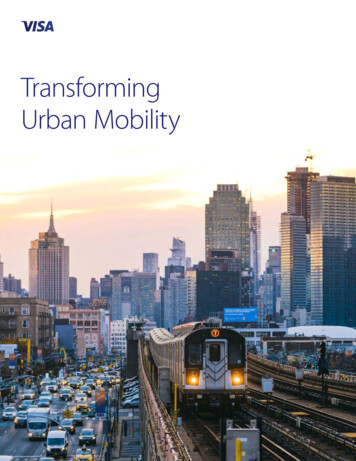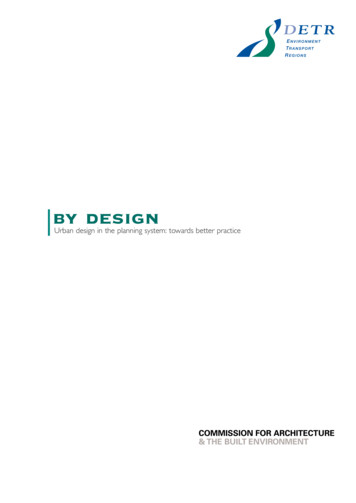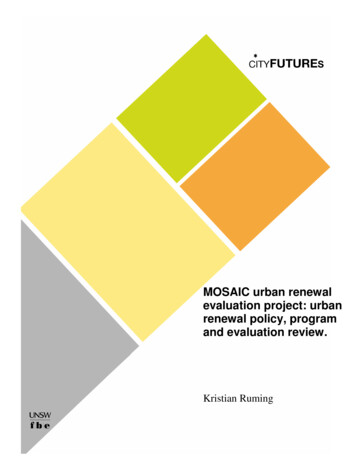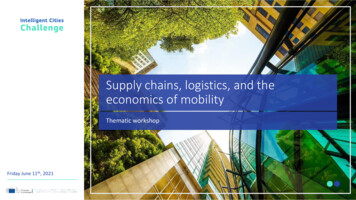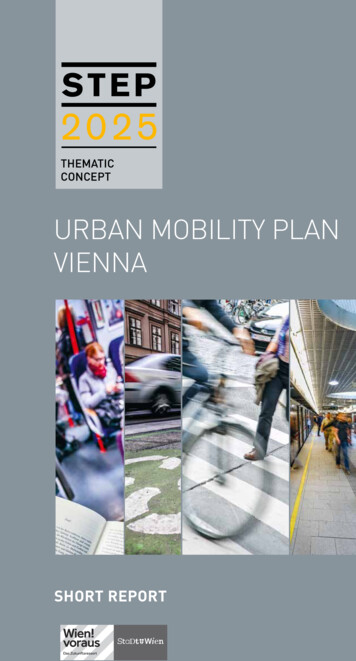
Transcription
THEMATICCONCEPTUrban Mobility PlanViennashort report
FulFilling the sustainable urban Mobility plan Criteria In the Urban Mobility Package [COM(2013) 913 f] published in December2013 the European Commission definedthe requirements to be fulfilled by urbanplanners to ensure sustainable mobility.Under the motto “Planning for People”,the Commission advocates the SUMPidea Europe-wide, thus fostering a clearshift from car- and traffic-focused urbanplanning towards more of a balancebetween all modes of transport, aimingat improved quality of life.The City of Vienna hired an externalquality assurance team to support thedevelopment of the urban mobility planand to do the first structured assessmentbased on the Sustainable Urban MobilityPlan approach ever done in Europe. Outof 100 possible points, the Vienna UrbanMobility Plan achieved 82, which spellsexcellence.In all assessment areas, performancewas above 50%. All mandatory criteriawere fulfilled. The Vienna Urban MobilityPlan is an ambitious and high-qualitydocument meeting Europe’s SUMPrequirements, which makes it a paragonof sustainable urban mobility planning.Frank Wefering and Siegfried Rupprecht,Rupprecht Consult – Forschung & Beratung GmbHApril 2015The SUMP criteria relate to six areas. A fact which deserves special mention isthat top scores were reached in two areas: in respect of integration, the guidingprinciple of any SUMP (including interdepartmental planning groups, intersectoralparticipation, the combination of urban planning and coordinated regionaldevelopment, ), the Vienna Urban Mobility Plan was fully in line with internationalstandards. The same applies to the sophisticated evaluation method with its extensiveand innovative set of indicators. This is crucial for implementation and ensures thatthe Plan is regularly revisited and updated.2
Photo: Lukas BeckIf we want environmental and climateprotection, we have to start workingwhere there is a need to catch up. InVienna, this applies to traffic. Between1995 and 2013, energy consumptionin this area rose by 50%, in particulardue to car traffic. No other field hasseen a similar growth rate. The problemis aggravated by the fact that 95% offuel used in traffic is mineral-oil basedwhilst climate change is becoming moreand more noticeable in Vienna. TheVienna Urban Mobility Plan is a packageof measures devised by the City ofVienna to improve the quality of air andleading to noise abatement, exhaust gasreduction and more green areas in thecoming ten years.This short report of the Vienna UrbanMobility Plan highlights the mostimportant solutions. It ties in with thesuccess stories of the past five years: amarked price reduction for annual publictransport season tickets, the expansionof parking space management, trafficcalming projects and a massiveboost to cycling and public transport.Building on this foundation, the ViennaUrban Mobility Plan leads the way to amobility system of the future by definingambitious goals and the measuresrequired to reach them. The exclusivereliance on infrastructure expansion hasalready proven insufficient in the past.Under the motto “Together on the move”,diverse and coordinated approaches willmake it possible for transport in Viennato continue being reliable while affectinglife in the city as little as possible andmeeting a wide variety of needs.Maria VassilakouDeputy MayorExecutive City Councillor forUrban Planning, Traffic and Transport,Climate Protection, Energy andPublic ParticipationForeword 3
togetheron the Move“Mobility requires human-scale and eco-compatible forms oftransport. the City of Vienna is committed to prioritising publictransport, pedestrians and cycling as the most environmentallyfriendly mobility modes. “Vienna embodies a future-oriented urbanmobility policy that is not only ecologically, but also economicallyand socially acceptable and hence sustainable. it is economicallysustainable because it is based on long-term investment that paysoff for the city and location. it is socially sustainable because itsdeclared goal is to ensure mobility for all citizens irrespective oftheir income, social position and life situation. it is ecologicallysustainable because it helps to conserve natural resources andcontributes to realising the Smart City Wien objective.”Quote from SteP 2025The Vienna Urban Mobility Plan reflectsthe consistent implementation of avision of the city enshrined in theUrban Development Plan STEP 2025:mobility in Vienna should be fair, healthy,compact, eco-friendly, robust andefficient. “Together on the move” is thebuzzword. In the years to come, Viennatransport policy will be uncompromisinglygeared to fostering eco-mobility.Expressed in modal split indicators, thetarget of STEP 2025 is “80:20”, whichmeans that the citizens of Vienna areto use public transport, cycle or walkto cover 80% of the trips they need tomake, whilst the share of car transportshould decrease from the present 28%to 20%. Walking and cycling are modesof active mobility, which means that theyare conducive to health. Eco-mobilityis considered an integrated system inthis concept - with optimised interfacesbetween modes of transport andadditional services of city-compatiblemobility (e.g. mobility cards, bike sharingand car sharing systems).Wherever additional high-capacity roadsare needed in new neighbourhoodsof the city, these will be planned in a4city-compatible way – offering sufficientspace to pedestrians and cyclists aswell as public transport, and attractivedesign which invites people to linger.The aim is to develop and use urbaninfrastructure as a resource in the mostefficient way possible.“Enabling mobility without carownership” is a central transport-policyconcern. The level of motorisation ofVienna’s population, i.e. the numberof motor vehicles per inhabitant, hasbeen decreasing to 381 passengercars per 1,000 inhabitants in the pastten years – which indicates that theprinciple of transport modes combinedflexibly according to people’s needsand circumstances is already workingwell as an appealing and crisis proof (hence robust) alternative. Thisrequires compact urban developmentand the continued expansion of thecity’s highly efficient public transportinfrastructure so it fulfils the needs of agrowing metropolis. Improvements inthe suburban railway and undergroundnetworks will remain the mainstay butat the same time, areas in between alsoneed to be provided with tangential tram
and bus lines to create a dense publictransport network with good connectionswithin the city and between the city andthe surrounding region.Close coordination and cooperation inmatters of transport and spatial planningwithin the entire Eastern Region iscrucial for the success of Vienna’stransport policy. This is why for the firsttime ever, the Vienna Urban MobilityPlan includes a regional mobility planprepared and supported by the threeprovinces Burgenland, Vienna and LowerAustria; it forms the basis of all local andregional measures in the mobility sectorand thus fills the idea “Together on themove” with life.The Vienna Urban Mobility Plan wasprepared by means of a far-reachingdiscussion process bringing togethermany institutions and representativesof organisations. The input generatedby a Citizens’ Council was likewiseincorporated. The Vienna Urban MobilityPlan was adopted by the City Councilas part of the Urban Development PlanSTEP 2025 in December 2014. Tyingin with STEP 2025 the Vienna UrbanMobility Plan provides detailed pointersfor sustainable mobility in Vienna. Goalswere defined and 50 packages ofmeasures were devised to contribute toreaching the goals.5
Fields oF aCtion For Mobilityin vienna Public space: Sharingstreets in a fair wayGovernance: Responsibilitiesand resourcesSharing instead of owningfairStreet space is allocatedfairly to a variety of usersand sustainable mobility willremain affordable for all.healthyTogether in the regioneco-friendlyMobility causes as littlepollution as possible, theshare of eco-mobility in thetrips made in Vienna and itsenvirons is rising.robustMobility in Vienna is .Mobility is as reliable andcrisis-proof as possible.Mobility is possible withoutnecessarily owning ameans of transport.The share of active mobilityin every-day life increases;accident-related personalinjuries decline.compactDistances covered betweenwork, home, errands andleisure time activities are asshort as possible.efficientResources are used in amore efficient way – helpedby innovative technologiesand processes.Business in motionTransport organisation:A smarter way ofmanaging mobilityTransport infrastructure:The backbone of the cityMobility needs innovationAMbitious goAls leAd the wAyThe future of mobility in Vienna is characterised by six goals which are pursuedsimultaneously and considered to be equivalent: fair – eco-friendly – robust – efficient– compact – healthy. To reach these goals, numerous measures are required andthese need to be implemented in a coordinated way. These measures and processeshave been clustered in nine fields of action.6Efficient mobility throughmobility managementindicAtors MAke it possibleto keep trAck of Mobility deVelopMentIndicators were identified for each of the six goals in the Vienna Urban Mobility Plan;these will make it possible to keep track of and control development in the next fewyears. For example, the share of surface areas being made available for cycling,walking and public transport is to be raised in all conversion and renewal projectsunder the “fair mobility” goal.7
8
nine FieldsoF aCtionThe Vienna Urban Mobility Plan listsmeasures leading to the goals in ninefields of action:– Public space:Sharing streets in a fair way– Governance: Responsibilitiesand resources– Efficient mobility through mobilitymanagement– Sharing instead of owning– Transport organisation:A smarter way of managing mobility– Transport infrastructure:The backbone of the city– Business in motion– Mobility needs innovation– Together in the regionAll measures and processes incorporatethe following principles:– Traffic safety: Due to a wide varietyof measures, traffic safety in Viennahas risen continuously for decades.The goal of the City of Vienna in trafficsafety is “Vision Zero”, i.e. no morefatal traffic accidents in the city.– Barrier freedom: In the past fewyears, many steps have been takentowards a barrier-free system in trafficand transport. Lowered kerbstones,acoustic traffic lights and tactileguidance systems contribute to makingit easier for persons with permanent ortemporary restricted mobility to movearound the city.– Gender mainstreaming and diversity:The proposed measures were testedfor the way in which they affectvarious user groups and adjustmentswere made on the basis of results(“Fairness Check”).9
publiC spaCe:sharingstreetsin a Fair wayMore spaCe For publiCtransport, CyClists andpedestriansIn the past, the design of streets wasoriented towards cars. At present, morethan 65% of street surfaces are used forthe flow of motorised traffic and parkingeven though only 28% of all trips aremade by car. In the past few years, anincreasing number of people switchedfrom driving a car to eco-mobility. Thisis why pedestrians, public transport andcycling are to be given more space in thefuture.Streets which are appealing topedestrians and cyclists are importantfor more people deciding to walk or usea bike.CoexistenCe in traFFiCMany conflicts between road usersemerge due to the fixed allocation ofspace to individual transport modes andthe insistence on one’s own rights whendifferent interests meet. In the future, the10aim is to see pedestrians, cyclists, publictransport users as well as those whodrive a car or ride a moped or motorbikeuse space in a fair and consideratemanner. In this context, the City ofVienna supports the introduction of moreshared spaces and temporary pedestrianzones. These measures are to improvecoexistence in traffic and the quality ofrest and recreation.aCtive and saFe Mobility Forthe youngestOn their way to school, more than 87%of 6- to 14-year-olds walk, use bicyclesor travel on public transport. The qualityand safety of school forecourts is to beimproved, so that there is enough openspace for children to arrive at and departfrom school safely. This is not only a wayof giving children more space in generalbut also to facilitate safe trips to schooland back home when they are on theirown.
space used per person according to mode of transport0.8 m23 m220 m25 persons, 40 km/h60 m21 person, 40 km/h9.4 m2Full, 40 km/h4.6 m2Full, 40 km/hThere is a tendency for the infrastructure capacity in a growing city to be overused, so that existing spacemust be used in the best way possible. The diagram shows the space used by each mode of transport.Adapted on the basis of: John Whitelegg (1993), Transport for a Sustainable Future: The Case for Europe, Bellhaven Press (1993).Representation by: Flow(n)/Mobility in ChainexeMplary Measuresa focus on coexistence in trafficThe City of Vienna supports measuresfor better “coexistence in traffic” aimingat fair and considerate cooperation, e.g.the creation of shared spaces.More quality and safety of schoolforecourtsNo-vehicle or traffic-calmed zones arecreated in front of schools and nurseryschools. Temporary no-vehicle zonesin front of schools are being tested aspilot projects before school starts in themorning.temporary opening of streets foractive mobilitySuitable street sections are turned intotemporary pedestrian zones, e.g. playstreets, at weekends – both in denselybuilt-up inner city districts and moresuburban areas.repurposing street areasWherever this is possible, selectedareas currently used as traffic lanes orfor turning/parking are made available forlingering, walking, public transport andcycling.11
governanCe:responsibilitiesand resourCesnew approaChesin adMinistrationinteraCtion oF publiCand private playersWith the city and the districtsbeing faced with new challenges,new approaches are needed inadministration. Societal tasks andproblems become ever more complex,the interests of different stakeholdersare more diverse than ever. To masterthe challenges new forms of cooperationand steering in the administrative contextas well as with the stakeholders outsidethe public administration are sought.“Governance” stands for a culture ofgood cooperation in decision-making andthus emphasises the interaction of publicand private players. In the planning andexecution of projects, public institutionsincreasingly look for cooperation withother stakeholders, such as enterprises,citizens and interest groups. The level ofthe city districts is especially importantfor the urban mobility plan: Many of themeasures proposed fall within their remit.exeMplary Measureslocal mobility plansThe challenges which certain largerparts of the city, i.e. districts orneighbourhoods, are faced withrequire integrated solutions acrosstransport modes. This is particularlytrue of the suburbs. Often enough,diverse measures and coordinatedprojects are needed, and these will inthe future be developed in the shapeof local mobility plans across districts.Regional connections across the citylimits reaching out into the environs arelikewise of central importance.12new priorities and requirements fortransport expert assessmentsAt present, expert assessments forthe construction of new roads orstreet conversion mainly look at privatemotorised transport. In the future,transport expert assessments will paymore attention to the transport modes ofeco-mobility.Coordination and classification of thestreet and route networkThis classification serves to visualise thefunctions and type of each street. It isa basis for the targeted expansion andconversion of Vienna’s street networkand an important prerequisite for furtherplanning, e.g. assessments as to wheretraffic calming or public transportprioritisation is possible and necessary.
eFFiCient Mobilityby MobilityManageMentEfficient mobility management influencesthe mobility behaviour of traffic partici pants by information, advice and a well coordinated range of services. After all,sustainable mobility is not only a matterof infrastructure but also of efficient useof what is available.gives faster access to various offerings,e.g. the annual public transport seasonticket, indoor car parks and bike-sharingstations, are trend-setting. Info pointsshould continue to exist for everyonewho does not use a computer andsmartphone.better ConneCtions thanksto extensive inForMationMobility ConsultanCyat the right tiMeMany people use a variety of trans port modes every day, and this trendwill not abate. This is why informationabout modes of transport and changingbetween them should be improved evenmore – both in digital form and as classicperson-to-person information. Innova tions such as the mobility card, whichMobility-related information and consul tancy are most successful when theyare available at turning points in life,when habits have to be adapted to newcircumstances - e.g. when children startschool, when people move or beginworking in a new job.exeMplary MeasuresMulti-modal mobility consultancy: aone-stop shopIn the past few years, the range ofmobility services has become larger butalso less easy to keep track of. A Vienna“Mobility Centre” will in the future bringtogether all information and become aone-stop shop for end users and a hubfor initiatives pertaining to all eco-mobilitymodes.Mobility management inschools and enterprisesSchools and enterprises are importantplaces in which to start fostering activemobility on the way to work or school.The City of Vienna will therefore do evenmore for mobility management in schoolsand enterprises.Mobility managementfor new neighbourhoodsPeople who move to a new home oftenuse this as a reason to rethink theirmobility needs. In the future, informationon mobility options will be distributedamong all the people moving into newhousing estates and more options will beavailable to them.private-law agreementson mobility issuesThese complement the zoning and land use plan when defined urban planningobjectives are to be implemented. In thefuture, mobility issues will be part of suchprivate-law agreements for the benefit ofpublic interests.13
sharinginsteadoF owning“Sharing instead of owning” is aninternational trend. Flats, furniture,gardens, equipment and even cars andbikes can be used by several persons.Access to shared use becomes morepragmatic, with efficiency, convenienceand cost reduction being the mostimportant motifs. The clear tendencyamong young people in big Europeancities is not to consider the car a (status)symbol any longer, they have less of awish to own one. Car sharing and bikesharing are booming in many cities andregions, they are seen as a complementto public transport. Permanent Internetaccess via smartphones facilitates the useof these services.Cars and bikesFor teMporary usebike sharing stationstrips on shared bikes per station1208.000The City of Vienna banks on bike sharingand car sharing as complementary topublic transport or walking for peoplewho do not own a car. One vehicle ina car sharing system replaces about4-8 private cars. By 2025, 50% of thepopulation should have a car sharinglocation within a maximum radius of 500metres from their home, and 40% shouldbe able to find a bike sharing stationwithin a maximum reach of 300 0002004 2005 2006 2007 2008 2009 2010 2011 2012 2013exeMplary MeasuresFurther development of bike sharingsystemsBike sharing is an eco-friendly multi modal service; the systems in thecentre of the city and in the suburbs aswell as (under regional cooperation) inthe Eastern region of Austria is beingexpanded. Connections with publictransport are easily feasible there.142004 2005 2006 2007 2008 2009 2010 2011 2012 2013Closer interlinkage of car sharing andpublic transportTogether with the public transportprovider Wiener Linien, the City ofVienna has prepared a car sharingstrategy to give providers wishing todo business in Vienna clear frameworkconditions.establishment of mobility pointsMobility points give uncomplicated andfast access to low-emission mobilityaround the clock.
transportorganisation:a sMarter way oFManaging MobilityThe effective interlinkage of publictransport, walking and cycling is one ofthe keys to strengthening eco-mobility.Apart from street conversions, changesin transport organisation are requiredto make this work. The advantage ofsuch measures is that they can be takenrelatively quickly and at comparatively littlecost. Shorter waits at intersections, shortand safe routes and punctuality of busesand trams make it particularly attractiveto move around on foot, by bike and onpublic transport.In general, Vienna is a city with many rulesand regulations. In the future, they are tobe reduced. New measures of transportorganisation can contribute to better“coexistence” in traffic.traffic light installations in Austria’s provincial capitals in relation to length of street network(Number of installations* per 10 km of kLinzSalzburgBregenz*Number of intersections with traffic lights, including crossings for pedestrians and cyclistsKlagenfurt St. Pölten EisenstadtData source: VCÖ 2014exeMplary Measuresshorter waits for pedestrians andcyclistsThe shortest possible maximum waits forpedestrians and cyclists are an importanttarget in the programming of trafficlights. To this end, the cycle times oftraffic lights are to be shortened.More intersections with simplifiedcontrolAt present, Vienna has about 1,300traffic light installations. By internationaland Austrian comparison, this is a largenumber. In the future, intersections atspots with low traffic density should beorganised without traffic lights to theextent that this is safely possible.accelerating majorpublic transport linesThe acceleration of public transport soas to actually shorten of door-to-doortransit times in surface transport, as wellas reliable, regular operations in keepingwith the timetables, and well-designedaccessways to and exits from stops arecrucial.shortening distances for cyclistsOpening one-way streets for two-waycycling to the greatest possible extent inVienna is to make cycling in the city evenmore appealing.15
transportinFrastruCture:the baCkboneoF the CityFunctioning transport infrastructure is acentral requirement for quality of life andbusiness activities, ensuring that peopleand goods reach their destinations andsafeguarding supply.Much is already being done in Vienna tofacilitate short distances between work,school, supplies for daily needs, placeof residence and leisure time facilities.Nevertheless, more traffic is expecteddue to the increase in population figuresand increased mobility. A shift towardseco-mobility is seen as desirable so thatthe number of trips in cars decreasesor at least does not rise – in spite of anincrease in the number of inhabitants.Bicycle and pedestrian traffic will growat the same time. Hence, investmentsinto related infrastructure are especiallyeffective and thus urgent.expansion oF publiCtransportUnderground, suburban railway andtram lines are being expanded andmade more attractive. The principleof developing public transport in newneighbourhoods in a timely manner iscontinued. The Vienna Urban MobilityPlan lays the foundation for another 12km of underground lines and 18 km oftram lines.out and about on FootSufficiently wide pavements (2 metrescontinue to be the minimum width),direct and appealing pathways shouldattract the population to walking more,not just during leisure time and whenrunning errands but also on the way towork and in every-day situations. TheVienna City Route Network will in thefuture offer barrier-free and convenientlinks between parts of districts, publictransport hubs and other importantdestinations in the city.CyCling on a day-to-day basisVienna’s cycling routes are to becomeeven better in quality in the future, andgaps in the networks will be closedso that cycling becomes a matter ofcourse for the majority of the population.Organisational measures – includingthe abolition of obligatory cycling pathuse, changes in traffic light phasing orthe conversion of surfaces no longerin use for car traffic – will complementthese measures. The long-distancecycling routes with their particularly highstandards serve as a flagship project inthis context.exeMplary MeasuresMulti-modal stopsPrimary hubs and highly frequentedstops are important leverage points forthe bundling and reconsidering of multi modal infrastructures. The design ofstops and their immediate environmentwill be in the focus of attention so thatpublic transport and additional transport16options can be used conveniently. Thiscan bring added value to public transportin the suburbs and the greater region,thus attracting potential new users.developing strolling promenadesOn a total of seven strolling promenadesmarked as such pedestrians will find
particularly high standards. The first twoprojects of this kind will be implementedby 2018.Edeveloping long-distancecycling routesTo foster long-distance cycling, includingcommuting by bike, the first longdistance route will be established by2013, with more to following by 2025.stepping up rail transport services forthe city and the regionThe “suburban train package” includesimproved services due to shorterintervals, better quality and coordinatedmarketing. The first elements can be feltin the short range; further improvementswill depend on future infrastructureprojects of the Austrian Federal Railwaysnetwork in the long run.FSuburban railOperationalimprovementsInfrastructure projectsEast-west axisTram linesTram project areas under the PublicTransport Investment Package of 27June 2014Tram projects under the Public TransportInvestment Package of 27 June 2014Further tram nd networkmodernisation andmaintenanceU4U617
businessin Motion The establishment and strengtheningof efficient transportation and logisticssystems is a central concern of the Cityof Vienna. Individual enterprises benefitas much from good conditions forcommercial transport as do customerswho receive goods in an expeditiousand cost-effective way - and Vienna asa competitive business location on thewhole.FunCtioning CoMMerCialtransport in a growing CityIf traffic increases on the whole asexpected due to the forecast populationgrowth, Vienna’s streets will be highlycongested unless there is a change inhabits. Modal shift towards eco-mobilitythus continues to be crucial to keepjourney times for commercial transportconstant or improve them.More eFFiCienCy,Fewer eMissionsIf it generates low noise and emissionlevels, logistics can make a significantcontribution to increasing the quality oflife and the environment in Vienna. TheCity of Vienna has identified a potentialfor e-mobility in vehicle fleets running upenormous mileage. Freight bikes are wellsuited for short-haul transport in the city.They need little space for parking, arelow in operating costs and can also beused in traffic-calmed zones. Goods canbe delivered without generating noiseand emissions, a fact which makes themparticularly efficient.exeMplary MeasuresFurther development ofgoods distribution centresThe two goods distribution centres in theport of Vienna and at the goods terminalof Inzersdorf are being developedfurther.Multifunctional lanes and loadingzones for private and businesstransportMultifunctional lanes are foreseen for usein new urban development areas andexisting neighbourhoods, where they willreplace conventional lanes for kerbsideparking. Parking will remain possible butthese lanes can be put to other uses,too.Community parcel boxesCommunity parcel or mailboxes arelockable containers in which parcels canbe deposited and from which deliveredgoods can be collected. They may behoused in empty ground floor shops ornear major public transport hubs, thushelping reduce the number of faileddelivery attempts and avoiding long tripsto collection points.good conditions for freight bikesThe City of Vienna will create therequired conditions to make the use offreight bikes materialise and also usemore of them in the municipal services.targeted funding of e-mobilityThe City of Vienna offers grants forthe purchase of electric vehicles, inparticular for company fleets.18
MobilityneedsinnovationResearch and innovation play a key rolewhen it comes to reaching the ambitiousmobility objectives Vienna has set foritself. Therefore, related measures aim atenabling the City of Vienna to contributeto lively developments in research andinnovation which it will also be able touse in practice.vienna innovationFor MobilityVienna has developed internationalinnovation in the fields of urban or publictransport on several occasions. Transportinformation systems such as the userportals “qando” and “AnachB I VOR”,marketing approaches such as the annualseason ticket for EUR 365.00 or vehicletechnology, including the ULF trams, thelowest ultra-low floor tram world-wide,offer particular added value to users.The City of Vienna would like tocontinue to actively advance researchand development, particularly in thecontext of projects and applicationswhich serve to strengthen eco-mobility.Multi-modality as well as walking, publicspaces and cycling will be in the focusof developments to a greater extent thanpreviously.exeMplary Measurestargeted use of fundingin research and innovationThe City of Vienna provides considerablefunding to business via its fundingagencies. When preparing calls, aspectsrelevant to mobility are to be included.Close cooperation withresearchers and teachersApart from direct bilateral contactsbetween the City of Vienna andteachers in institutions of tertiaryeducation, instruments such as endowedprofessorships, PhD colleges, platformsfor diploma theses and researchcooperation intens
contributes to realising the Smart City Wien objective." Quote from SteP 2025 . The Vienna Urban Mobility Plan relects the consistent implementation of a vision of the city enshrined in the Urban Development Plan STEP 2025: mobility in Vienna should be fair, healthy, compact, eco-friendly, robust and eficient. "Together on the move" is the

